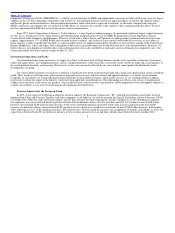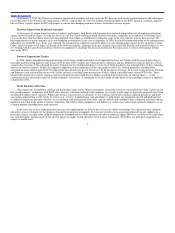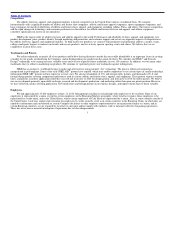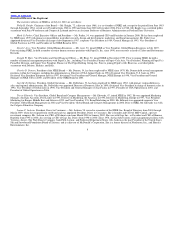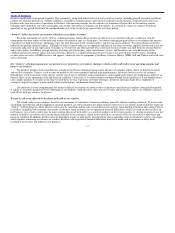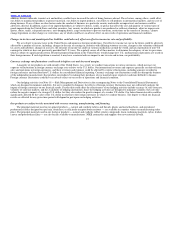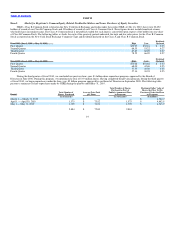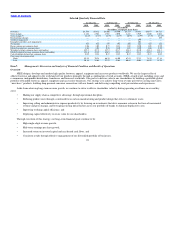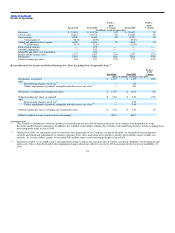Nike 2010 Annual Report Download - page 18
Download and view the complete annual report
Please find page 18 of the 2010 Nike annual report below. You can navigate through the pages in the report by either clicking on the pages listed below, or by using the keyword search tool below to find specific information within the annual report.
Table of Contents
addition, disease outbreaks, terrorist acts and military conflict have increased the risks of doing business abroad. These factors, among others, could affect
our ability to manufacture products or procure materials, our ability to import products, our ability to sell products in international markets, and our cost of
doing business. If any of these or other factors make the conduct of business in a particular country undesirable or impractical, our business could be
adversely affected. In addition, many of our imported products are subject to duties, tariffs, or quotas that affect the cost and quantity of various types of
goods imported into the United States and other countries. Any country in which our products are produced or sold may eliminate, adjust or impose new
quotas, duties, tariffs, safeguard measures, anti−dumping duties, cargo restrictions to prevent terrorism, restrictions on the transfer of currency, climate
change legislation or other charges or restrictions, any of which could have an adverse effect on our results of operations and financial condition.
Changes in tax laws and unanticipated tax liabilities could adversely affect our effective income tax rate and profitability.
We are subject to income taxes in the United States and numerous foreign jurisdictions. Our effective income tax rate in the future could be adversely
affected by a number of factors, including: changes in the mix of earnings in countries with differing statutory tax rates, changes in the valuation of deferred
tax assets and liabilities, changes in tax laws, the outcome of income tax audits in various jurisdictions around the world, and any repatriation of non−US
earnings for which we have not previously provided for U.S. taxes. We regularly assess all of these matters to determine the adequacy of our tax provision,
which is subject to significant discretion. Recently proposed legislation in the United States would change how U.S. multinational corporations are taxed on
their foreign income. If such legislation is enacted, it may have a material adverse impact to our tax rate and in turn, our profitability.
Currency exchange rate fluctuations could result in higher costs and decreased margins.
A majority of our products are sold outside of the United States. As a result, we conduct transactions in various currencies, which increase our
exposure to fluctuations in foreign currency exchange rates relative to the U.S. dollar. Our international revenues and expenses generally are derived from
sales and operations in foreign currencies, and these revenues and expenses could be affected by currency fluctuations, including amounts recorded in
foreign currencies and translated into U.S. dollars for consolidated financial reporting. Currency exchange rate fluctuations could also disrupt the business
of the independent manufacturers that produce our products by making their purchases of raw materials more expensive and more difficult to finance.
Foreign currency fluctuations could have an adverse effect on our results of operations and financial condition.
Our hedging activities (see Note 18 — Risk Management and Derivatives in the accompanying Notes to the Consolidated Financial Statements),
which are designed to minimize and delay, but not to completely eliminate, the effects of foreign currency fluctuations may not sufficiently mitigate the
impact of foreign currencies on our financial results. Factors that could affect the effectiveness of our hedging activities include accuracy of sales forecasts,
volatility of currency markets, and the availability of hedging instruments. Since the hedging activities are designed to minimize volatility, they not only
reduce the negative impact of a stronger U.S. dollar, but they also reduce the positive impact of a weaker U.S. dollar. Our future financial results could be
significantly affected by the value of the U.S. dollar in relation to the foreign currencies in which we conduct business. The degree to which our financial
results are affected for any given time period will depend in part upon our hedging activities.
Our products are subject to risks associated with overseas sourcing, manufacturing, and financing.
The principal materials used in our apparel products — natural and synthetic fabrics and threads, plastic and metal hardware, and specialized
performance fabrics designed to repel rain, retain heat, or efficiently transport body moisture — are available in countries where our manufacturing takes
place. The principal materials used in our footwear products — natural and synthetic rubber, plastic compounds, foam cushioning materials, nylon, leather,
canvas and polyurethane films — are also locally available to manufacturers. NIKE contractors and suppliers buy raw materials in bulk.
15


